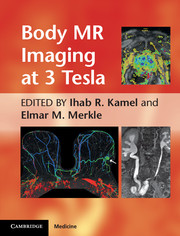Book contents
- Frontmatter
- Contents
- Contributors
- Foreword
- Preface
- Chapter 1 Body MR imaging at 3T: basic considerations about artifacts and safety
- Chapter 2 Novel acquisition techniques that are facilitated by 3T
- Chapter 3 Breast MR imaging
- Chapter 4 Cardiac MR imaging
- Chapter 5 Abdominal and pelvic MR angiography
- Chapter 6 Liver MR imaging at 3T: challenges and opportunities
- Chapter 7 MR imaging of the pancreas
- Chapter 8 MR imaging of the adrenal glands
- Chapter 9 Magnetic resonance cholangiopancreatography
- Chapter 10 MR imaging of small and large bowel
- Chapter 11 MR imaging of the rectum, 3T vs. 1.5T
- Chapter 12 Imaging of the kidneys and MR urography at 3T
- Chapter 13 MR imaging and MR-guided biopsy of the prostate at 3T
- Chapter 14 Female pelvic imaging at 3T
- Index
- Plate section
- References
Chapter 2 - Novel acquisition techniques that are facilitated by 3T
Published online by Cambridge University Press: 05 August 2011
- Frontmatter
- Contents
- Contributors
- Foreword
- Preface
- Chapter 1 Body MR imaging at 3T: basic considerations about artifacts and safety
- Chapter 2 Novel acquisition techniques that are facilitated by 3T
- Chapter 3 Breast MR imaging
- Chapter 4 Cardiac MR imaging
- Chapter 5 Abdominal and pelvic MR angiography
- Chapter 6 Liver MR imaging at 3T: challenges and opportunities
- Chapter 7 MR imaging of the pancreas
- Chapter 8 MR imaging of the adrenal glands
- Chapter 9 Magnetic resonance cholangiopancreatography
- Chapter 10 MR imaging of small and large bowel
- Chapter 11 MR imaging of the rectum, 3T vs. 1.5T
- Chapter 12 Imaging of the kidneys and MR urography at 3T
- Chapter 13 MR imaging and MR-guided biopsy of the prostate at 3T
- Chapter 14 Female pelvic imaging at 3T
- Index
- Plate section
- References
Summary
Introduction
Compared with lower field strength systems, magnetic resonance (MR) at 3T has many theoretical and real advantages. Included in the advantages are higher signal-to-noise ratios (SNRs) as well as larger spectral separation of fat, water, and various metabolites which can be used to improve fat saturation techniques as well as MR spectroscopy methods. In addition to these advantages that can be applied to already routine clinical imaging, 3T systems also provide advantages that can be exploited for novel techniques. This chapter will outline the advantages of 3T systems in terms of basic physics considerations, application, and advantages in routine sequences as well as potential application in novel imaging techniques such as MR spectroscopy, diffusion-weighted imaging (DWI), arterial spin labeling (ASL), susceptibility-weighted imaging (SWI), as well as magnetic resonance elastography (MRE).
- Type
- Chapter
- Information
- Body MR Imaging at 3 Tesla , pp. 12 - 25Publisher: Cambridge University PressPrint publication year: 2011
References
- 1
- Cited by

